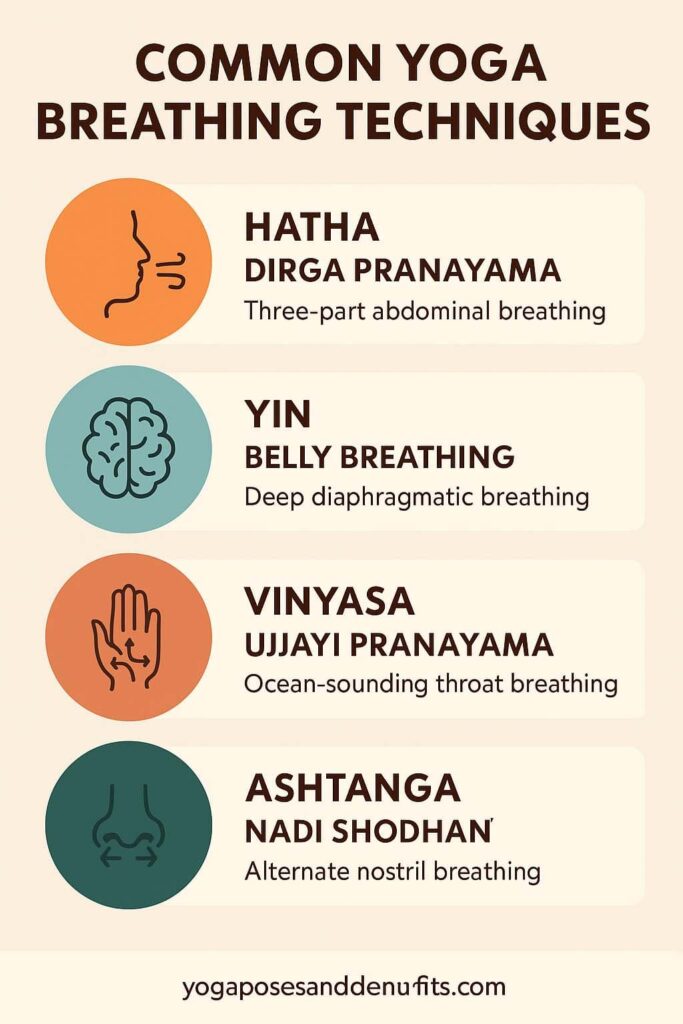Understanding the Role of Breath in Hatha Yoga
Why Breath Awareness Matters in Hatha Practice
In Hatha Yoga, the way you breathe plays a vital role in regulating prana (life force), soothing the nervous system, and fostering internal focus. Breath control influences the autonomic nervous system—particularly the parasympathetic branch—helping to reduce heart rate and support vagal tone. Slow, conscious breathing stimulates the vagus nerve and improves communication between the gut and brain, supporting emotional equilibrium.
The diaphragm is central to yogic breathing, initiating movement from the stomach upward. When you inhale deeply into the abdomen, you train the diaphragm to activate more fully. This encourages abdominal breathing and stimulates baroreceptors, which regulate cardiovascular stability.
Unlike passive, shallow breathing, Hatha Yoga breathing techniques engage multiple systems including respiratory, circulatory, and neural networks. Each breath becomes a bridge from physical postures to meditative states. You don’t just breathe—you connect.
Breathing Techniques vs. Casual Breathing
Untrained breath often becomes shallow, chest-focused, and inefficient. Many people fail to engage the diaphragm and instead breathe through accessory muscles. This limits oxygen flow and creates tension. In contrast, the breath in Hatha Yoga is deliberate, slow, and nasal, often starting from the stomach and rising up.
Each inhale and exhale is consciously extended to improve oxygenation and relax the nervous system. Controlled abdominal breathing increases lung capacity and engages the intercostal muscles and diaphragm. When you inhale through the nose and exhale slowly, the parasympathetic system activates, calming both body and mind.
This structured approach to breathing transforms even simple yoga postures into deeply immersive experiences. As you breathe with intention, physical practice becomes an integrated exploration of awareness, calm, and focus.
Essential Hatha Yoga Breathing Techniques
Dirga Pranayama (Three-Part Breath)
Dirga Pranayama, or the three-part breath, begins in the stomach, rises to the ribs, and finishes in the upper chest. This deep abdominal breathing technique teaches you to maximize lung capacity and involve the full respiratory system.
Inhale through the nose, fill the stomach, then the rib cage, and finally the upper chest. As you exhale, reverse the sequence. This pattern trains you to lengthen both inhalation and exhalation. It also increases diaphragm efficiency and oxygen uptake.
Practicing Dirga Pranayama enhances pulmonary health, soothes the nervous system, and creates a focused mindset. It is ideal at the beginning or end of a Hatha Yoga class to ground awareness and relax the body.
Place one hand on your stomach and the other on your chest to feel each breath phase. The tactile feedback improves breath control and makes you more present in your practice.
Nadi Shodhana (Alternate Nostril Breathing)
Nadi Shodhana involves breathing through one nostril at a time to cleanse and balance energy channels. You begin by closing the right nostril and inhaling through the left nostril, then switch sides for the exhale.
This technique not only balances the nervous system but also synchronizes brain hemispheres. It helps reduce mental noise and improves emotional control by stabilizing breath rhythms and regulating oxygen delivery.
Practice in a seated posture with your spine tall. Use your thumb and ring finger to alternate nostrils. This form of breathwork can be deeply calming and is especially useful before meditation or during high stress.
By inhaling and exhaling mindfully through the nose, you activate the parasympathetic response and create coherence across multiple body systems.
Ujjayi Pranayama (Victorious Breath)
Ujjayi breath uses slight constriction of the throat to create a whisper-like sound as you inhale and exhale through the nose. This generates internal heat, builds focus, and supports fluid movement through yoga postures.
Inhale deeply into the stomach, allowing the breath to rise steadily to the chest. The controlled, rhythmic exhale calms the mind and strengthens the diaphragm. Ujjayi increases oxygen efficiency and improves stamina.
This technique is commonly practiced in dynamic styles like Vinyasa and Ashtanga, but in Hatha it serves to connect breath with slower, deliberate movements. It helps you pace your transitions and sustain attention throughout your practice.
Bhramari (Bee Breath)
Bhramari pranayama involves a soft humming sound on each exhale, producing vibration through the skull and facial bones. This resonance activates the vagus nerve, calming the limbic system and reducing stress.
Sit comfortably and close your eyes. Inhale through the nose, then exhale slowly while humming like a bee. The vibration around the sinuses and forehead soothes the mind and encourages introspection.
Covering your ears with your thumbs can intensify the effect. This technique is especially beneficial in the evening or after an intense yoga session. It promotes pratyahara, or sensory withdrawal, drawing attention inward for meditation.

How to Incorporate Breathing Techniques Into Your Hatha Practice
Timing and Sequence in a Hatha Yoga Class
Integrate breathwork at strategic moments to complement each phase of your Hatha Yoga practice. Begin with Dirga or Nadi Shodhana to center and prepare. Use Ujjayi during postures to regulate energy and focus. Close with Bhramari to bring the system into stillness.
This breath sequencing supports the transition from activity to rest and enhances communication between brain and body. The sequence begins with abdominal breathing to activate the diaphragm and ends with nasal exhalation to reinforce calm.
Linking breath to posture increases somatic awareness. When the breath initiates each movement, the nervous system adapts more quickly to the rhythm of practice, improving coordination and ease.
Beginner Tips for Yogic Breathing

For beginners, focus on breathing through the nose and feeling expansion in the stomach. Avoid forcing the inhale or holding the breath. Instead, lengthen the exhale slightly longer than the inhale to naturally calm the system.
Use abdominal breathing while lying down to develop awareness. Place your hand on your stomach to feel it rise and fall with each breath. This reinforces diaphragmatic engagement and breaks the habit of shallow chest breathing.
Practice at the same time daily, even for five minutes. Over time, your breath will become a grounding tool in yoga and in daily life. It creates a foundation of calm, clarity, and resilience.
The Transformative Power of Hatha Yoga Breathing Techniques
Breathing as a Bridge Between Body and Mind
The breath serves as a unifying thread in every Hatha Yoga practice. Each inhale through the nose draws energy inward; each exhale calms the body and clears mental static. Breathing techniques engage the diaphragm, nervous system, and sensory perception—aligning body, breath, and awareness.
Whether you’re practicing Dirga for grounding, Ujjayi for flow, or Nadi Shodhana to balance the left nostril and right nostril pathways, each method supports health, emotional regulation, and mindfulness.
Breath is not only vital for movement; it is essential for stillness. With each cycle of inhale and exhale, you anchor yourself in the present moment. Over time, breathing becomes a practice of presence—both on and off the mat.

